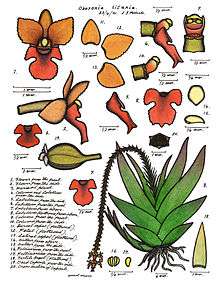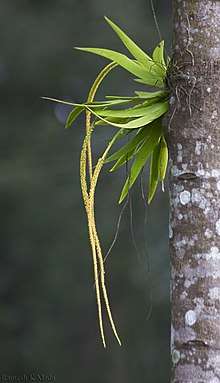Oberonia
Oberonia, commonly known as fairy orchids,[2] is a genus of flowering plants in the family Orchidaceae. Orchids in this genus are epiphytic or lithophytic plants with the leaves arranged fan-like, overlapping at the base and spreading near the tips. Large numbers of tiny, short-lived, cup-shaped, non-resupinate flowers are arranged on an arching flowering stem that emerges from the base of the uppermost leaf. There are about 240 species occurring from tropical and southern Africa to the Pacific.
| Fairy orchids | |
|---|---|
 | |
| Oberonia titania illustration by Lewis Roberts | |
 | |
| Oberonia sp. Nagara Hole National Park, India | |
| Scientific classification | |
| Kingdom: | |
| (unranked): | |
| (unranked): | |
| Order: | |
| Family: | |
| Subfamily: | |
| Tribe: | |
| Genus: | Oberonia |
| Species | |
| Synonyms[1] | |
Description
Orchids in the genus Pinalia are epiphytic or lithophytic, sympodial herbs with the leaves in an unusual fan-like arrangement, in two overlapping rows near the base before spreading. A large number of tiny, non-resupinate, short-lived flowers are arranged in whorls or spirals along an arching flowering stem. The sepals and petals are all more or less similar to and free from each other although the petals are narrower than the sepals. The labellum is rigidly fixed to the base of the column and usually has three lobes.[2][3][4][5]
Taxonomy and naming
The genus Oberonia was first formally described in 1830 by John Lindley who published the description in The Genera and Species of Orchidaceous Plants.[1][6][7] The name Oberonia is a reference to Oberon, the king of the fairies, referring to the tiny flowers of these orchids and to their unusual arrangement on the flowering stems.[3][7]
Distribution
Orchids in the genus Oberonia are native to tropical Africa, southern Asia including India, China, Japan, Indochina, Indonesia and the Philippines) and to Australia, and various islands of the Pacific and Indian Oceans.[1]
See also
References
- "Oberonia". World Checklist of Selected Plant Families (WCSP). Royal Botanic Gardens, Kew.
- Jones, David L. (2006). A complete guide to native orchids of Australia including the island territories. Frenchs Forest, N.S.W.: New Holland. pp. 468–469. ISBN 1877069124.
- "Oberonia". Trin keys. Retrieved 15 January 2019.
- Chen, Xinqi; Ormerod, Paul; Wood, Jeffrey J. "Oberonia". Flora of China. Retrieved 15 January 2019.
- "Oberonia". Orchids of New Guinea. Retrieved 15 January 2019.
- "Oberonia". APNI. Retrieved 15 January 2019.
- Lindley, John (1830). The Genera and Species of Orchidaceous Plants. Piccadilly: Ridgways. p. 15. Retrieved 15 January 2019.
External links
